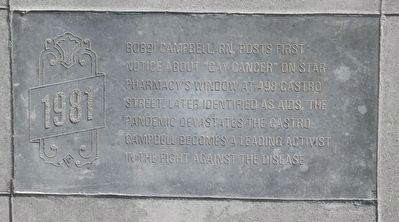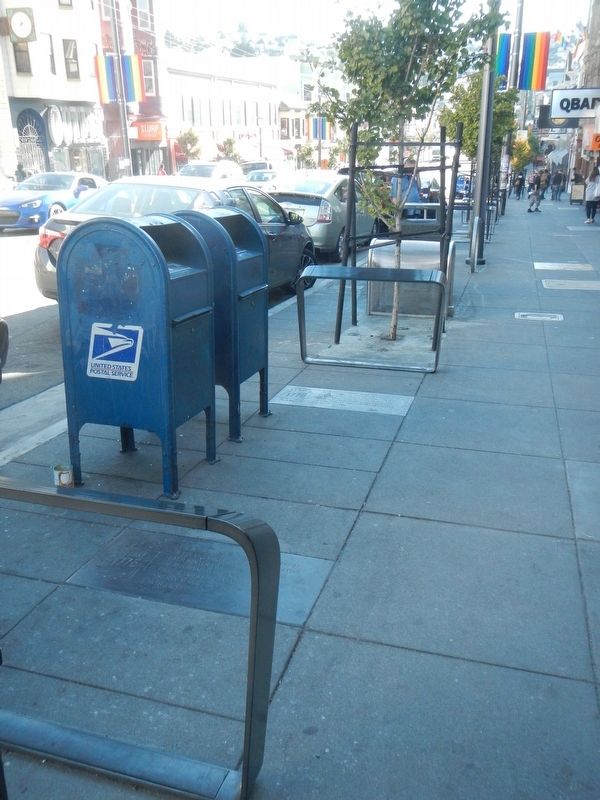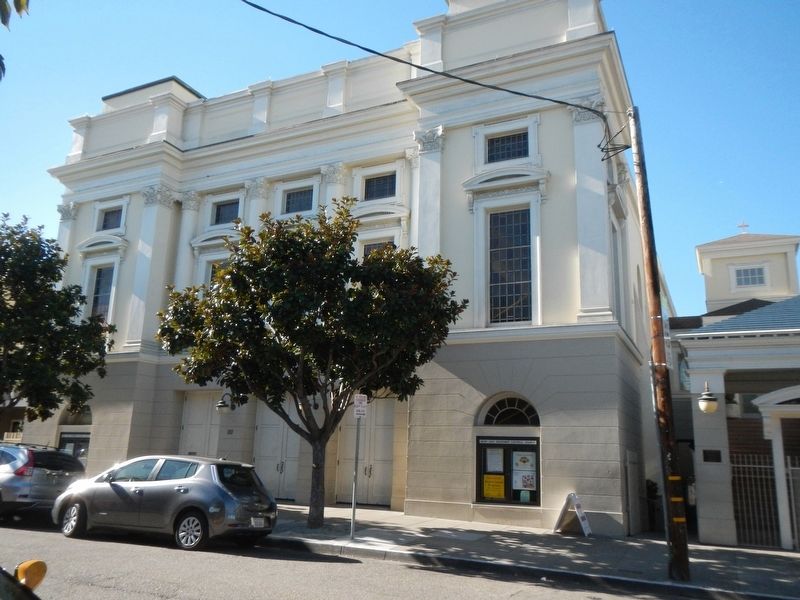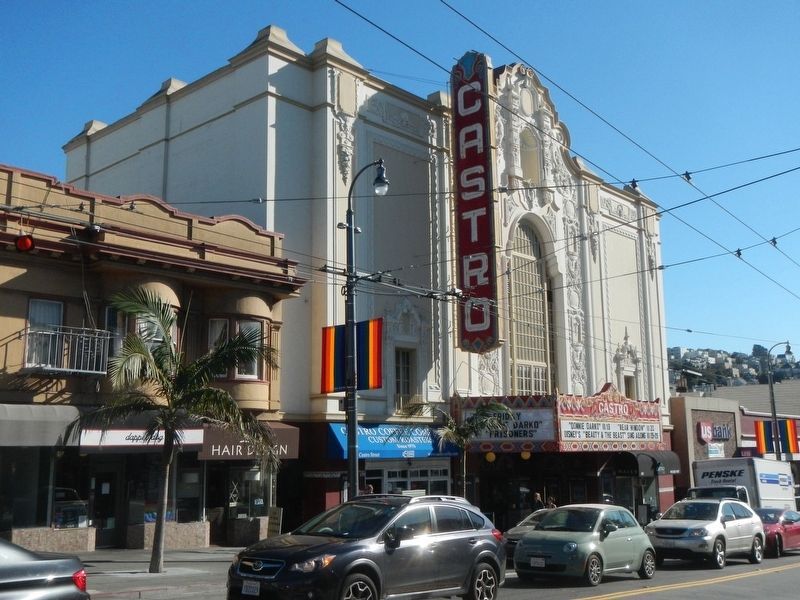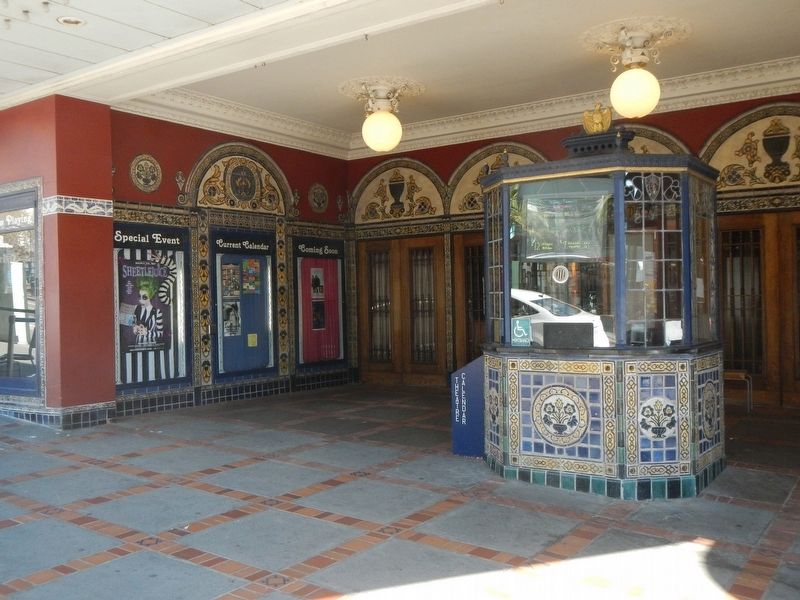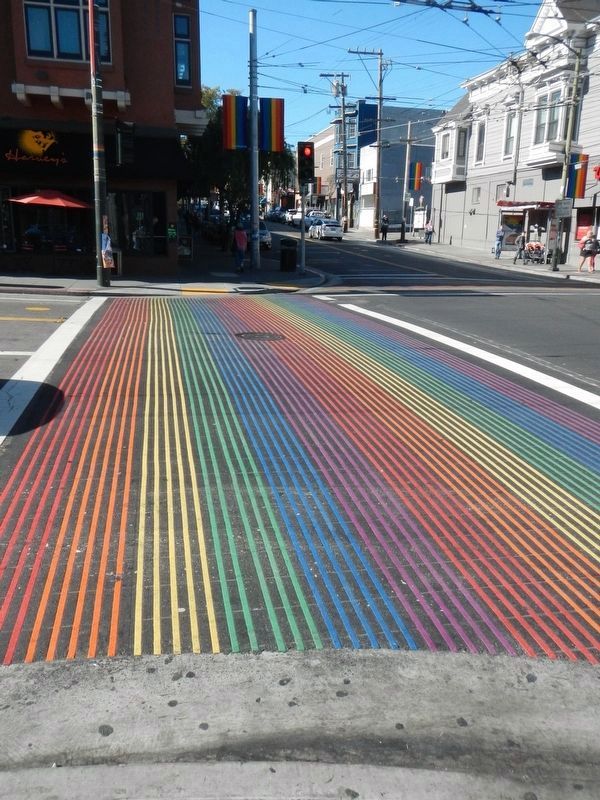The Castro in San Francisco City and County, California — The American West (Pacific Coastal)
Castro Street Historical Timeline
Inscription.
Nineteen tablets embedded in the sidewalk line each side of Castro Street between Market Street and 19th Street.
Before 1776 The native Yelamu people live nearby in the village of Hutchuei, relocating each winter to the bayside village of Sitlintac. A creek flows past grassland and chaparral toward the bay along the path of today's 18th Street.
1776 Spanish colonists name the local creek Arroyo de los Dolores and established Mission San Francisco de Asis (Mission Dolores) near its banks. The Mission Dolores system dismantles ancient Yelamu society, and disease decimated the population.
1846 Mexico grants former Mission lands to citizens, including Jose de Jesus Noe, the last Mexican alcalde (mayor) of Yerba Buena (San Francisco). Noe's 4,444 acre Rancho San Miquel encompasses area later known as Eureka Valley.
1854 American settler John Horner purchases a portion of Rancho San Miquel. Castro Street ,named after a prominent Mexican-era Californio family, marks the western border of the nascent neighborhood known as Horner's Addition.
1895 Five room cottages on Castro Street rent for about $15 a month. Transit improvements, including the Castro Street Cable Car, spur settlement by working class Irish, German, and Scandinavian families in the late 19th century.
1902 Most Holy Redeemer Catholic Church is built at Diamond and 18th Stree. For many decades residents refer to the neighborhood as the Most Holy Redeemer Parish rather than Eureka Valley.
1907 The Swedish American Hall opens at 2174 Market Street. Upper Market Street in Eureka Valley come to be known for its concentrations of social clubs, churches, and businesses serving the neighborhood's large Scandinavian community.
1914 Thousands attend the first known festival on Castro Street to celebrate the groundbreaking of the Twin Peaks Tunnel. The San Francisco Chronicle declares the celebration "a riot of hilarity and merry making." The tunnel opens in 1918.
1922 The Wasser brothers open the Castro Theatre, the first movie palace designed by prominent architect Timothy Pflueger. An early usherette at the theatre, Janet Gaynor, goes on to win best actress at the first Academy Awards in 1929.
1943 Castro Street becomes nationally known as the setting of Mama's Bank Account, a novel by local Norwegian American author Kathryn Forbes. It inspires the Broadway play I Remember Mama as well a 1948 movie and 1950s television series.
1953 Lesbian couple Del Martin and Phyllis Lyon move into their first home together in San
Francisco on Castro Street. They help establish the Daughters of Bilitis, the first national lesbian rights organization.
1963 The Missouri Mule opens as the first gat bar in Eureka Valley, which soon becomes known as the Castro. In 1972 Twin Peaks Tavern becomes the first U.S. Gay Bar with clear, full length windows, a sign of the the community's growing pride.
1977 Castro resident merchant and activist Harvey Milk, known as "The Mayor of Castro Street," is elected to the San Francisco Board of Supervisors becoming one of the first openly gay elected officials in the country.
1978 San Francisco Supervisor Harvey Milk and Mayor George Moscone are assassinated November 27. As news of the tragedy spreads, tens of thousands of mourners spontaneously gathers on Castro Street and form a candlelight march to City Hall.
1979 The assassin of Supervisor Milk and Mayor Moscone is a cleared of murder charges. The jury verdict outrages the gay community, spurring riots at City Hall and a retaliatory police ransacking of the Elephant Walk Bar at 900 Castro Street.
1981 Bobbi Campbell, RN, posts first notice about "Gay Cancer" on Star Pharmacy's window at 498 Castro Street. Later identified as AIDS, the pandemic devastates the Castro. Campbell becomes a leading activist in the fight against the disease.
1982 The Sisters of Perpetual Indulgence, a queer activist and charity group, founded in 1979 organized one of the world's first AIDS related fundraisers, a dog show on Castro Street. Local resident and disco star Sylvester is one of the judges.
1987 Cleve Jones's concept for an AIDS memorial quilt becomes the NAMES Project at 2362 Market Street. Throughout the 1980s numerous organizations take root in the Castro to fight for awareness, treatment and prevention of HIV/AIDS.
2013 National attention turns to the Castro as thousands gather to celebrate the U.S. Supreme Court decision allowing same sex marriages in California, marking a milestone in the neighborhood's historic role as a center for LGBT rights.
Topics. This historical marker is listed in these topic lists: Notable Events • Notable Places. A significant historical date for this entry is November 27, 1776.
Location. 37° 45.723′ N, 122° 26.112′ W. Marker is in San Francisco, California, in San Francisco City and County. It is in The Castro. Marker can be reached from Castro Street near Market Street. Touch for map. Marker is at or near this postal address: 430 Castro Street, San Francisco CA 94114, United States of America. Touch for directions.
Other nearby markers. At least 8 other markers are within walking distance of this marker. Jane Addams (here, next to this marker); Virginia Woolf (within shouting distance of this marker); James Baldwin (within shouting distance of this marker); Harvey Milk (within shouting distance of this marker); Tennessee Williams (within shouting distance of this marker); The Rainbow Flag (within shouting distance of this marker); Officer Jane Warner (within shouting distance of this marker); Oscar Wilde (within shouting distance of this marker). Touch for a list and map of all markers in San Francisco.
More about this marker. Nineteen tablets embedded in the sidewalk line each side of Castro Street between Market Street and 19th Street.
Also see . . .
1. Castro District, San Francisco. Wikipedia entry:
The Castro District, commonly referenced as The Castro, is a neighborhood in Eureka Valley in San Francisco. The Castro was one of the first gay neighborhoods in the United States. Having transformed from a working-class neighborhood through the 1960s and 1970s, the Castro remains one of the most prominent symbols of lesbian, gay, bisexual, and transgender (LGBT) activism and events in the world. (Submitted on November 20, 2016, by Barry Swackhamer of Brentwood, California.)
2. The Castro - San Francisco. SFGate website entry:
If only the Mexican land barons and European homesteaders who built the Castro district could see it — and the price of its real estate — today. What was once dairy farms and dirt roads is now one of the city's most vibrant and cohesive communities, saturated with stylish shops and bars so popular that patrons spill out onto the street. (Submitted on November 20, 2016, by Barry Swackhamer of Brentwood, California.)
3. A Brief History of The Castro Theatre, San Francisco. Culture Trip website entry (Submitted on January 4, 2022, by Larry Gertner of New York, New York.)
Additional keywords. LGBT LGBTQ
Credits. This page was last revised on October 31, 2023. It was originally submitted on November 20, 2016, by Barry Swackhamer of Brentwood, California. This page has been viewed 604 times since then and 38 times this year. Photos: 1, 2, 3, 4, 5, 6. submitted on November 20, 2016, by Barry Swackhamer of Brentwood, California.
